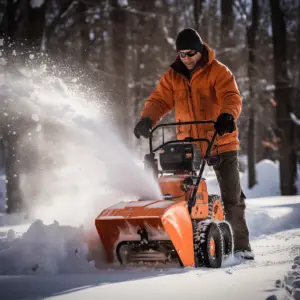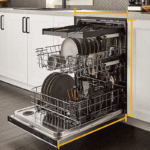Snow blower start-up issues and fixes, During winter, snow removal is at the top of most to-do lists seasonally. Although the snow blower is commonly used to clear snow quickly and easily, unexpected issues can occur, giving you a setback as ice and snow pile at your outdoor.
The prevalent problems are starting issues, clogged chutes, and drive loss. However, you can fix these issues by understanding how you can troubleshoot these issues along with the proper maintenance and tools.
In this guideline, we’ll help you solve the issue of your Troy Bilt Storm 2410 not starting. Let’s get started.
Table of Contents
Troy Bilt Storm 2410 Won’t Start

Because your snow blower has been dormant during the summer, starting it up might need some coaxing. First, remove any remaining gasoline from the previous winter’s container and refill it with new petrol.
Secondly, check the tank to ensure you have adequate oil to avoid damaging your engine due to insufficient oil.
Before pulling the trigger, ensure the valve is adjusted, and the priming bulb is pushed a few times before your first pull.
Finally, check out your snow blower spark plug to see if it is disconnected, coated with buildup, or corroded. If you notice any of these issues, try to clean or replace your spark plug as per the manufacturer’s instructions.
That said, let’s look at each of them individually in a more comprehensive way.
Troy Bilt Storm 2410 Electric Plug
Check the spark plug for any signs of wear or damage. If there are cracks on the porcelain insulator, an electrode is damaged, or it is coated by carbon buildup, you should replace the plug. A spark plug tester is advisable to establish whether the pin is at fault.
The plug is in good condition if there is a vital spark between the tester’s terminals when the engine is cranking. The lack of spark signifies that the pin is at fault and needs to be replaced.
Clogged Carburetor
Another reason for your snow blower not starting is a blocked carburetor caused by leaving oil/fuel in the device for a long duration. Over time, as the engine sits, some of the oil components (MTBE and alcohol- Ethanol) evaporate, leaving behind a gum-like substance.
The sticky fuel can cause blockage of the carburetor and hinder the engine from starting. Therefore, troubleshoot the problem using a carburetor cleaner, and if it doesn’t work, rebuild or replace the whole carburetor.
Flywheel Key
It is a minor metal piece that attaches to the crankshaft and contacts the flywheel. It protects the engine from damage. For instance, if the engine suddenly stops from hitting a hard object, the flywheel key disintegrates in half to protect the engine from damage.
To check whether the flywheel key is damaged, remove the flywheel from the engine and then inspect its state. If it is broken, you need to replace it.
Ignition Coil
A faulty ignition may prevent the engine from starting. While running, the ignition coil supplies voltage to the spark plug. Make sure the spark plug works before proceeding.
After checking it, test the ignition coil with an ignition coil analyzer and fix snow blower start-up issues.
Recoil Starter
The recoil spring pulls the starter rope onto a pulley when pulled and released. Breaking the recoil prevents the string from recoiling onto the pulley, preventing engine start-up. The recoil starter assembly can only be replaced, but replacing the spring recoil independently is faster.
Chute Blockage
Most snow blower devices have chutes like the 2 stage FLEX Snow Blower Accessory that enables you to change the path and pitching of snow as you navigate through Snow blower start-up issues and fixes.
Heavy debris and deep snow might clog your snow blower’s chute, demanding you to perform a drastic adjustment on the fly based on your brand.
Additionally, use the shovel-shaped tip of the cleaning tool to break down and damage any heavy snow buildup in and around the chute component. Reattach the cleaning tool to the fastening clamp after the chute is clear
Reinstall the starter keys and restart your Troy Bilt Storm after cleaning and securing all equipment. Remove any remaining icy conditions from the chute assembly by activating the screw controls in the operator’s position behind the snow blower.
3 Easy Fixes for Other Common Snow-Blower Problems

Below is a quick caption of some of the snow blower problems you may encounter and how you can fix them.
Too Much Snow Left Behind By the Machine
The flat metal bar beneath the machine chisels snow and ice from the ground into the drill. Passing over concrete, asphalt, and gravel makes the metal wear down, leaving furrows behind.
Prop the snow blower up and remove the bolts that hold the bar to the housing, replacing them with a new one.
Snow Blower Runs Rough
Is your gas blower shaky or jittery when Snow blower start-up issues and fixes is on? The issue might be a problem with fuel combustion. Therefore, check the fuel or spark plugs.
Drain the oil fuel from the tank and refill it with clean, fresh gas to fix the problem.
After unplugging the rubber boot engaged to the plug and removing the pin with a ratchet wrench, replace the spark plug with a new one. Take note that you also need a unique plug socket at home or the
Running Engine, But the Auger Won’t Turn
Inspect the drill when the engine is off to see if there is any problem like chunk ice holding the moving parts from turning. Check on the shear pins near the drill as you refer to the manual for the exact location as they break if your machine hits on a hard object.
Replacement of these pins should get your snow blower to function again.
In summary, your snow blower starts within the three pulls of the starter rope. When it fails to start, follow a step-to-step guideline to troubleshoot the reasons causing the problem: Check the fuel levels, spark plug, carburetor, and compression, and follow the tips shared herein. If it fails to start, then take it in for professional service.


